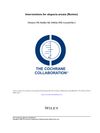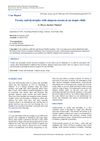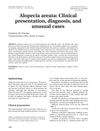TLDR New treatments for alopecia areata may target specific immune cells and pathways involved in hair loss.
The document discussed new drug treatment opportunities for alopecia areata based on a genome-wide association study that implicated T cell and natural killer (NK)-cell activation pathways. It highlighted the UL 16-binding protein (ULBP3) gene cluster on chromosome 6q25, which produces NKG2D-activating ligands that can trigger an autoimmune response. Increased expression of ULBP3 was found in hair follicles of patients with active disease, suggesting that T cells are attracted to the hair follicle by these ligands, leading to the characteristic "swarm of bees" infiltrate. Future treatments may involve drugs that block the NKG2D ligand-receptor interaction, halt activated T cells, or modify the inflammatory cytokine network, with many drugs used for other autoimmune diseases potentially being effective for alopecia areata.
717 citations
,
June 2010 in “Nature” Alopecia areata involves both innate and adaptive immunity, with specific genes linked to the disease.
244 citations
,
January 2010 in “Journal of the American Academy of Dermatology” The document says current treatments for alopecia areata do not cure or prevent it, and it's hard to judge their effectiveness due to spontaneous remission and lack of studies.
91 citations
,
January 2010 in “Journal of Allergy and Clinical Immunology” NK cells play a role in skin diseases like eczema and psoriasis.
 164 citations
,
April 2008 in “Cochrane library”
164 citations
,
April 2008 in “Cochrane library” Current treatments for alopecia show no significant long-term benefits.
 1 citations
,
January 2022 in “Dermatology Reports”
1 citations
,
January 2022 in “Dermatology Reports” Many people with hair loss, especially those with telogen effluvium and alopecia areata, often have a sensitive scalp.
 April 2019 in “International journal of research in dermatology”
April 2019 in “International journal of research in dermatology” A child with rough nails also had hair loss and allergies.
September 2014 in “DOAJ (DOAJ: Directory of Open Access Journals)” Rosemary is as effective as Minoxidil for treating alopecia areata.
 109 citations
,
May 2011 in “Dermatologic Therapy”
109 citations
,
May 2011 in “Dermatologic Therapy” Alopecia areata is a type of hair loss that can lead to complete baldness, often associated with other autoimmune conditions, and half of the cases may see hair return within a year.




